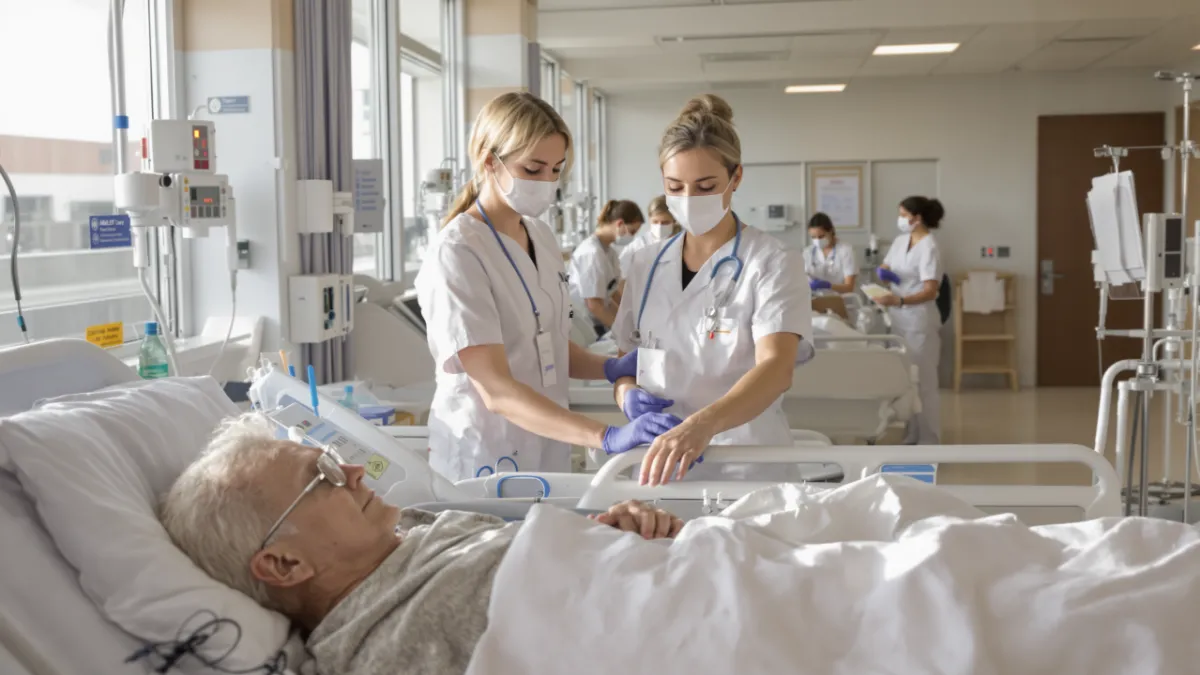Nursing Role in Harm Prevention: The Frontline Defense in Patient Safety
Date published: May 16 2025

The Unsung Guardians of Patient Safety
In today’s increasingly complex healthcare environment, nurses are not just caregivers they are safety advocates, critical thinkers, and frontline defenders against patient harm. Nurses’ vigilance and expertise play a pivotal role in recognizing early signs of deterioration, coordinating interventions, and preventing common but often devastating complications such as falls, infections, and pressure injuries.
Let’s explore the key dimensions of harm prevention in which nurses are essential.
Recognizing Patient Deterioration & Rapid Response Teams
timely recognition of a patient’s clinical deterioration can mean the difference between life and death. Nurses, through their constant presence and clinical assessment skills, often detect subtle changes in a patient's condition before they escalate. Understanding the concepts of “Failure to Rescue” is crucial in to ensure timely nursing interventions and the escalation of concerns to healthcare providers. Initiating a Rapid Response Team (RRT) is one of the most effective interventions at this critical juncture. RRTs bring advanced clinical expertise to the bedside swiftly, often preventing ICU transfers or cardiac arrests.
Real-world Insight: A study in Resuscitation found that over 80% of in-hospital cardiac arrests are preceded by abnormal vital signs, underscoring the importance of early detection by nursing staff.
Preventing Patient Falls & Venous Thromboembolism (VTE)
Falls are a persistent challenge in inpatient care and are often preventable. Nurses implement fall risk assessments, initiate safety measures like bed alarms, and educate patients on mobility practices. Meanwhile, to combat VTE a potentially fatal but preventable condition nurses monitor mobility, administer prophylactic medications, and ensure adherence to sequential compression devices.
Resource: ECRI’s 2024 report highlighted patient falls as a continuing top safety concern, reinforcing the need for proactive nursing interventions.
Preventing Pressure Ulcers
Pressure ulcers, or bedsores, are not just painful they’re dangerous indicators of poor care. Through regular repositioning, skin assessments, and the use of pressure-relieving devices, nurses prevent the formation of ulcers, especially in immobile patients. The use of standardized risk tools like the Braden Scale is common practice among vigilant nursing teams.
Tip: Implementing a “turning team” strategy has been shown to significantly reduce pressure ulcer incidence in high-risk hospital units.
Preventing Healthcare-Associated Infections (HAIs)
From meticulous hand hygiene to managing central lines and catheters, nurses are on the front lines of infection prevention. HAIs, such as catheter-associated urinary tract infections (CAUTIs) and central line-associated bloodstream infections (CLABSIs), can prolong hospital stays and increase mortality. Nursing-led initiatives like infection control bundles have dramatically improved outcomes.
Link: Explore how hand hygiene programs have reshaped infection control via the AACN’s infection prevention strategies.
Discharge Planning & Medication Reconciliation
A safe discharge is a coordinated process, not a checklist. Nurses play a critical role in ensuring patients understand their post-hospital care, including medication regimens, follow-up appointments, and symptom monitoring. Medication reconciliation—a process to avoid adverse drug events due to prescription errors or omissions—is largely a nursing responsibility. Ensuring an accurate med list at transitions of care is crucial for safety.
Example: Poor discharge planning is a leading cause of hospital readmissions. Effective nursing-led discharge teaching reduces this risk significantly, particularly for elderly or chronically ill patients.
Why This Matters Now
With healthcare systems strained and patient complexity on the rise, the margin for error is shrinking. Yet, research consistently shows that investment in nursing staffing and education directly correlates with better patient outcomes and lower rates of harm. Nurses are uniquely positioned to lead safety initiatives, often acting as the final barrier between a patient and preventable harm.
“Every patient deserves and has the right to expect and experience safe healthcare.” — Julie Siemers, Surviving Your Hospital Stay
How is your organization supporting nurses in their harm prevention roles? If you're a nurse, what tools or practices have helped you the most?
Visit our website https://drjuliesiemers.com/lifebeat-solutions/ and book a consultation with us. For inquiries, you can also reach out via email at [email protected].
#PatientSafety #Nursing #Healthcare #NurseLeadership #HarmPrevention
Nursing Role in Harm Prevention: The Frontline Defense in Patient Safety
Date published: May 16, 2025

The Unsung Guardians of Patient Safety
In today’s increasingly complex healthcare environment, nurses are not just caregivers they are safety advocates, critical thinkers, and frontline defenders against patient harm. Nurses’ vigilance and expertise play a pivotal role in recognizing early signs of deterioration, coordinating interventions, and preventing common but often devastating complications such as falls, infections, and pressure injuries.
Let’s explore the key dimensions of harm prevention in which nurses are essential.
Recognizing Patient Deterioration & Rapid Response Teams
Timely recognition of a patient’s clinical deterioration can mean the difference between life and death. Nurses, through their constant presence and clinical assessment skills, often detect subtle changes in a patient's condition before they escalate. Understanding the concepts of “Failure to Rescue” is crucial in to ensure timely nursing interventions and the escalation of concerns to healthcare providers. Initiating a Rapid Response Team (RRT) is one of the most effective interventions at this critical juncture. RRTs bring advanced clinical expertise to the bedside swiftly, often preventing ICU transfers or cardiac arrests.
Real-world Insight: A study in Resuscitation found that over 80% of in-hospital cardiac arrests are preceded by abnormal vital signs, underscoring the importance of early detection by nursing staff.
Preventing Patient Falls & Venous Thromboembolism (VTE)
Falls are a persistent challenge in inpatient care and are often preventable. Nurses implement fall risk assessments, initiate safety measures like bed alarms, and educate patients on mobility practices. Meanwhile, to combat VTE a potentially fatal but preventable condition nurses monitor mobility, administer prophylactic medications, and ensure adherence to sequential compression devices.
Resource: ECRI’s 2024 report highlighted patient falls as a continuing top safety concern, reinforcing the need for proactive nursing interventions.
Monitoring and Reporting
Collecting and analyzing data on safety incidents to identify trends and areas for improvement.
Establishing Standards
Developing and enforcing safety protocols to ensure consistency and quality across healthcare organizations.
Promoting Education
Providing training and resources to healthcare professionals to enhance their knowledge and skills in patient safety.
Encouraging Transparency
Creating a culture where healthcare workers feel empowered to report errors and near-misses without fear of retribution.

Driving Innovation
Leveraging technology and research to implement cutting-edge solutions for patient safety challenges.

Preventing Pressure Ulcers
Pressure ulcers, or bedsores, are not just painful they’re dangerous indicators of poor care. Through regular repositioning, skin assessments, and the use of pressure-relieving devices, nurses prevent the formation of ulcers, especially in immobile patients. The use of standardized risk tools like the Braden Scale is common practice among vigilant nursing teams.
Tip: Implementing a “turning team” strategy has been shown to significantly reduce pressure ulcer incidence in high-risk hospital units.
Preventing Healthcare-Associated Infections (HAIs)
From meticulous hand hygiene to managing central lines and catheters, nurses are on the front lines of infection prevention. HAIs, such as catheter-associated urinary tract infections (CAUTIs) and central line-associated bloodstream infections (CLABSIs), can prolong hospital stays and increase mortality. Nursing-led initiatives like infection control bundles have dramatically improved outcomes.
Link: Explore how hand hygiene programs have reshaped infection control via the AACN’s infection prevention strategies.
Discharge Planning & Medication Reconciliation
A safe discharge is a coordinated process, not a checklist. Nurses play a critical role in ensuring patients understand their post-hospital care, including medication regimens, follow-up appointments, and symptom monitoring. Medication reconciliation—a process to avoid adverse drug events due to prescription errors or omissions—is largely a nursing responsibility. Ensuring an accurate med list at transitions of care is crucial for safety.
Example: Poor discharge planning is a leading cause of hospital readmissions. Effective nursing-led discharge teaching reduces this risk significantly, particularly for elderly or chronically ill patients.
Why This Matters Now
With healthcare systems strained and patient complexity on the rise, the margin for error is shrinking. Yet, research consistently shows that investment in nursing staffing and education directly correlates with better patient outcomes and lower rates of harm. Nurses are uniquely positioned to lead safety initiatives, often acting as the final barrier between a patient and preventable harm.
“Every patient deserves and has the right to expect and experience safe healthcare.” — Julie Siemers, Surviving Your Hospital Stay
How is your organization supporting nurses in their harm prevention roles? If you're a nurse, what tools or practices have helped you the most?
Visit our website https://drjuliesiemers.com/lifebeat-solutions/ and book a consultation with us. For inquiries, you can also reach out via email at [email protected].
#PatientSafety #Nursing #Healthcare #NurseLeadership #HarmPrevention
